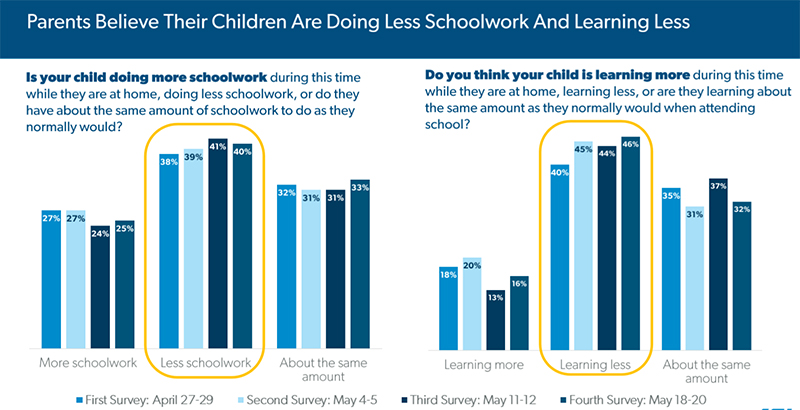Analysis: How Are Families Navigating COVID-19? This Week-by-Week Survey of 500 Parents Has Some Answers

COVID-19 has disrupted the lives of millions of Americans, but for parents, it has created a unique set of challenges. Many suddenly found themselves homeschooling their kids, working from home, facing reduced hours at their jobs or, in some cases, unemployed.
To better understand how parents are navigating these challenges, the American Enterprise Institute is analyzing weekly surveys, conducted by Echelon Insights, of 500 public school parents. The results of these surveys, which began April 27, provide a unique insight into the concerns and experiences of parents through their evolving responses to COVID-19. These responses can also help leaders with their plans for reopening schools.
Among parents’ top concerns are family members getting COVID-19 (59 percent) and making sure their children are ready for the next grade (60 percent). Nearly 60 percent are concerned about their children missing important social interactions.
Financial security splits along income and education attainment lines. More than 60 percent of families making less than $50,000 are worried about making ends meet, compared with 30 percent of families making more than $75,000. A similar pattern reflects the financial security that higher levels of education provide. Nearly 60 percent of parents with a high school diploma or less say that they are worried, compared with just 30 percent of parents with a bachelor’s degree or higher.
Parents’ survey responses show a clear trend toward using the $1,200-per-adult and $500-per-child cash benefit provided under the CARES Act to meet basic needs. Over the course of four weeks, more parents reported using their benefit to buy groceries (up from 27 percent to 37 percent) and to pay for utilities, including internet access (up from 24 percent to 34 percent). Forty-three percent now say they need help covering the costs of basic necessities, up from 20 percent in the first week of the survey, and there is widespread support (above 70 percent) across income levels, racial demographic groups and political ideology for closing the home connectivity gap, likely reflecting the new reality of connectivity being essential to access educational services, content and instruction.
Parents surveyed also echo concerns about the potential learning loss students might experience as a result of school closures and uneven implementation of remote instruction. Across income levels, racial demographics and political ideology, parents believe that their children are spending less time on their schoolwork (40 percent) and are learning less (46 percent) than they normally would in school.
The majority of parents (61 percent) want schools to use this moment as an opportunity to rethink how we educate students and come up with new ways to teach children. This support has stayed consistently strong over the past four weeks, which should give school leaders permission to explore innovative models of learning and instructional approaches for the next academic year.
Parents are also consistent in looking for ways to keep their children engaged as well as stay informed about their academic progress. And there is broad support for the various measures and precautions schools will need to have in place in order to reopen. More than 77 percent of parents support allowing students or teachers to continue remote learning if they don’t feel safe going to school. Temperature checks before students enter school are supported by 78 percent of parents.
Parents overwhelmingly trust health officials for information over other policymakers and local leaders. Nearly a quarter say they trust the federal Centers for Disease Control and Prevention the most, 13 percent trust state public-health officials, and 12 percent trust local public-health officials. There are important differences here along racial lines: Nearly 31 percent of nonwhite parents trust the CDC, versus only 18 percent of white parents. Nonwhite parents are also more likely to trust governors (12 percent) than white parents (7 percent). This is an important insight, as it suggests the messenger is as important as the message. Policymakers and school leaders should look to involve health officials in communicating the steps needed to protect teachers and students when school resumes.
Beyond physical health, nearly half of the parents surveyed worry a lot or some about how the situation is affecting their children’s mental health and emotional well-being, and a substantial share say there have been negative effects on their children’s emotions. Parents report that their children are feeling lonely (31 percent), anxious (28 percent) and scared (18 percent), and they think that providing counseling and mental health support for students and staff is also critically important (65 percent).
Understanding parents’ concerns and preferences is vitally important to informing public policy and planning for the reopening of schools. This survey series reveals that many low-income parents are struggling to weather the economic shocks caused by COVID-19 and that all parents are deeply concerned about their children’s academic and emotional well-being. Future surveys will help to capture the experiences of parents as local economies restart and back-to-school plans become clearer.
John Bailey is an adviser to the Walton Family Foundation and a visiting fellow at the American Enterprise Institute. He previously served in the White House and U.S. Department of Education. He worked on pandemic preparedness at the U.S. Department of Commerce in 2006. Olivia Shaw is a research assistant of education policy studies at AEI.
Disclosure: The Walton Family Foundation provides financial support to The 74.
Get stories like these delivered straight to your inbox. Sign up for The 74 Newsletter

;)
